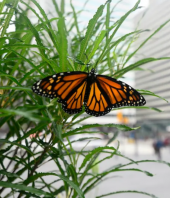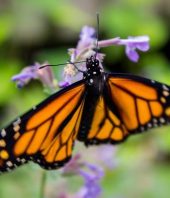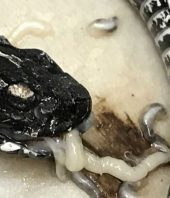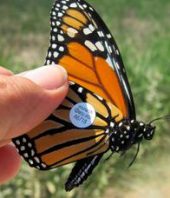For monarch butterflies in the eastern United States, life revolves around milkweed, a group of about 100 plants in the genus Asclepius that provide food, shelter and nectar for the iconic insects. During their annual migration to the their overwintering sites in the mountains of Mexico, millions of the butterflies float from milkweed to milkweed and other native flowers, on an epic 2,000-mile journey. But in recent years, things have gotten dicey for the orange and black lepidopteron on their journey.
Frankie Schembri at Science reports that researchers have detected a new threat: some monarchs are cutting their migration short due to non-native milkweeds in the South, where they’re picking up parasites.
Over the last 20 years, increased use of herbicides and other cultivation practices have decimated the population of common milkweed in the Midwest. It’s believed the loss of 1.3 billion stems of milkweed in recent decades is the major factor in the decline of the butterflies, which have plummeted from 682 million in 1997 to 93 million this year.
In response, many gardeners have begun adding milkweed species to their plantings, including the non-native tropical milkweed, Asclepias curassavica, in coastal regions like South Carolina, Texas and Florida. Unlike native milkweeds, which die out in late summer, forcing the monarchs to move on, their tropical cousin lives year-round, providing leaves for caterpillars to munch on and flowers for adults to drink from.
This has led to the establishment of year-round resident colonies of monarchs in some areas. It has also led to increased infection with a protozoan parasite called Ophryocystis elektroscirrha, that shortens the butterflies’ lifespan and makes it difficult to fly. When native milkweeds die off, the parasite dies with them, meaning there’s fresh, uncontaminated milkweed each spring. Since tropical milkweed doesn’t die off, the parasites keeps spreading.
According to a press release, ecologists from the University of Georgia wanted to understand how this new plant and these new colonies of monarchs might impact the natural migratory population. So in the fall and spring, the team worked alongside with a band of citizen-scientists at nine sites along the Texas coast. Half of those sites contained only native milkweed species and the other half included tropical milkweed. The team sampled 500 of the butterflies and were able to distinguish between resident insects and migratory insects by analyzing their wings because the type of milkweed they munch on and the location it grows in leaves a chemical fingerprint.
“We wanted to understand if relatively healthy migratory butterflies were coming into contact with these really sick butterflies along their migratory routes, and if they showed evidence of being at higher risk for parasites, or changing their movement behaviors,” says research leader Dara Satterfield, formerly of the University of Georgia but now at the Smithsonian.
What they found is that about 95 percent of the resident monarchs feasting on the tropical milkweed were infected with the parasite, while only 9 percent of migratory monarchs had the parasite, according the new study published in the journal Ecology Letters. However, about 25 percent of the migratory monarchs found visiting their cousins in the patches of tropical milkweed had the infection.
Shemberi reports that doesn’t mean the migratory butterflies are picking up the bug from their sedentary cousins, though it’s possible. Instead, the parasite infected migratory monarchs may have dropped out of the long journey for health reasons and instead of dying off, found a nice, cushy place to rest in the tropical milkweed. It’s also possible that once they find the green, healthy tropical milkweed it triggers biological changes which cause them to stop their migration and begin mating.
That's not the only problem with the tropical plant. The team also found that in the spring, when the monarchs begin migrating north, some of them stop and lay their eggs in the tropical milkweed colonies, raising the chances that their developing caterpillars will be infected with the parasite.
While it might seem nice to have monarchs year-round, migration serves important purposes. The grueling journey tends to purge the population of insects infected with parasites, keeping monarchs as a whole more safe. However, by supporting resident populations with high infection rates, the tropical milkweed makes the parasite more prevalent.
The situation has the potential to negatively impact the already beleaguered butterfly. “The ecology of monarchs is intimately linked to that of their milkweed food plants,” co-author Mark Hunter of the University of Michigan says in the release. “When we alter the distribution and abundance of milkweeds, either by introducing exotic species or eliminating native species, we should expect to see negative consequences for monarchs.”
While other factors impacting monarchs will take a lot of effort to fix, like planting billions of stems of milkweed, modifying insecticide use, creating habitat corridors and somehow preventing cars from killing the bugs, this problem has a simpler solution.
The researchers suggest replacing tropical milkweed with native plants. And if that’s not appealing, they recommend cutting the plants down to six-inch stems in the late summer and fall, which will not hurt the plant as it will quickly regrow, but will encourage monarchs to continue on their ancient journey to Mexico rather than making a parasitic pitstop.
Source: Smithsonian Magazine, Full Article






